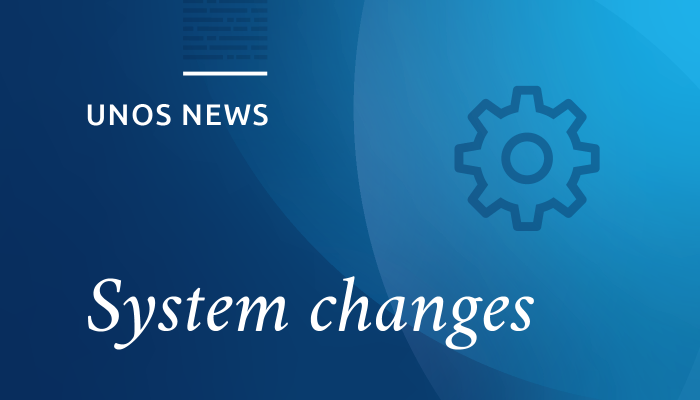Audience: (Please share this notice with anyone in your organization who would benefit from it.)
- Lung Primary Program Administrators, Primary Data Coordinators, Primary Physicians, Primary Surgeons
- Lung TX Program Administrators/Managers, TX Program Directors, TX Program Medical Directors, Clinical Training Coordinators/Managers, TX Program – Clinical Coordinators, Support Staff-Clinical, Data Coordinators, Regulatory Affairs Coordinators/Managers, Compliance Officers, Quality Directors/Managers, Quality Coordinators, TX Program Surgical Directors, TX Surgeons
- The Board of Directors of the Organ Procurement and Transplantation Network
- Members of the Lung Transplantation Committee
Implementation date
September 30, 2021
- Candidates’ Lung Allocation Scores (LAS) will be changing according to revised calculation approved by the OPTN Board of Directors in December 2020.
- The values used to calculate a candidate’s LAS will be updated to use data from a more recent cohort of lung candidates and recipients. The update will improve the prediction of candidates’ expected survival on the waitlist and post-transplant to improve equity in lung allocation.
- Several variables will be removed from the WaitlistSM mortality calculation and the post-transplant mortality calculation. These variables will no longer expire, but will continue to be available for reporting on the Waitlist.
- Additional changes to lung data fields approved by the OPTN executive committee in July 2021 will take effect when the revised LAS is implemented.
- The following variables will be removed from the waitlist mortality measure calculation:
- Lung diagnosis:
- Obliterative bronchiolitis (non-retransplant) or constrictive bronchiolitis
- Lymphangioleimyomatosis
- Eisenmenger’s syndrome
- Bilirubin increase greater than or equal to 50%
- Diabetes
- Forced vital capacity (FVC)
- Cardiac index (CI)
- Central venous pressure (CVP)
- Lung diagnosis:
- The following variables will be removed from the post-transplant survival measure calculation:
- Lung diagnosis:
- Lymphangioleimyomatosis
- Eisenmenger’s syndrome
- Pulmonary fibrosis, other specify cause
- Functional status
- Serum creatinine increase greater than or equal to 150%
- Lung diagnosis:
- Each remaining variable will be updated to reflect coefficient changes based on the new cohort.
- Other key changes to waitlist include:
- Collecting separate dates for candidate height and weight, to better align with current clinical practice.
- BMI expiration will be based only on the date the candidate’s weight was measured.
- The lung diagnosis “Secondary pulmonary fibrosis (specify cause)” will be removed from the diagnosis list.
- Candidates on the waitlist with this diagnosis will automatically be converted to a primary lung diagnosis of “pulmonary fibrosis, other specify cause” upon implementation.
- Candidates with a lung diagnosis of “COVID-19: pulmonary fibrosis” will have the same waitlist mortality measure covariate applied that is currently applied to candidates with a diagnosis of “pulmonary fibrosis, other specify cause.”
- Changes to the Supplemental O2 L/min field to reduce decimal precision to just 2 decimal places. Additionally, the maximum reportable value will increase from 26.3 to 26.33 L/min.
- Collecting separate dates for candidate height and weight, to better align with current clinical practice.
- Transplant centers should review the lung diagnosis options for their candidates currently listed with a diagnosis of “secondary pulmonary fibrosis (specify cause)” to ensure that the automatic conversion to “pulmonary fibrosis, other specify cause” is correct.
- Transplant centers may need to review and/or revise their current practices for reporting height and weight evaluation dates to ensure accuracy.
- If you normally convert 100% oxygen to a value in L/min when entering the candidate’s supplemental O2 information, you will be able to enter a more precise value of 26.33 in the L/min field, instead of 26.3.
- Continue to report optional lung data variables, when available, to inform ongoing lung policy improvements.
Education and resources
A detailed explanation for the changes can be found in the policy notices for Updated Cohort for Calculation of the LAS and Refine Lung Data Fields.
Questions
If you have questions relating to data or matching applications, contact UNOS Customer Service at [email protected], or call 800-978-4334 from 8 a.m. to 7 p.m. ET.
For policy-related questions, contact [email protected].
The Organ Center is available 24 hours a day at 800-292-9537.

